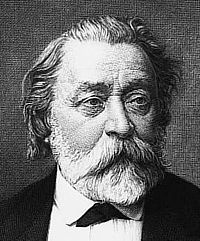Theophil Hansen
This article includes a list of general references, but it lacks sufficient corresponding inline citations. |


Baron Theophil Edvard von Hansen (German: [ˈteːofiːl fɔn ˈhanzn̩]; original Danish name: Theophilus Hansen pronounced [teoˈfiːlus ˈhanˀsn̩]; 13 July 1813, in Copenhagen – 17 February 1891, in Vienna) was a Danish architect who later became an Austrian citizen. He became particularly well known for his buildings and structures in Athens and Vienna, and is considered an outstanding representative of neoclassicism.
Biography
After training with Karl Friedrich Schinkel and some years studying in Vienna, he moved to Athens in 1837, where he studied architecture and design, with a concentration and interest in Byzantine architecture. During his stay in Athens, Hansen designed his first building, the National Observatory of Athens and two of the three contiguous buildings forming the so-called "classical trilogy", namely the Academy of Athens and the National Library of Greece, the third building of the trilogy being the National and Capodistrian University of Athens, which was designed by his brother Christian Hansen. The Greek-Austrian Georgios Sinas (who donated the observatory) called Hansen 1846 to Vienna, where Hansen took up an apprenticeship with noted Austrian architect Ludwig Förster.
In his early works, such as the museum at The Arsenal in Vienna, Hansen was still rather aligned to a more romantic style. In later years, he became the most outstanding representative of Renaissance-inspired historicism (Neo-Renaissance), which also came to be known as Viennese-style. This style extended into the smallest details of the interior design and partially accepted the courses of a synthesis of the arts.
Along with Förster and many others, Hansen was one of the most important and influential architects of the Viennese Ringstraße. His most famous work is the Austrian Parliament building, which was created in the style of an ancient, neo-classic temple, and serves to refer to the Greek beginnings of democracy. Hansen was originally a staunch critic of the Classical style that was taught to him at the Copenhagen Academy. Over the years, however, he came to incorporate Classical elements into his forms. Bauleiter on this project was Hans Auer, who would go on to win the competition for the Swiss Bundeshaus.
Hansen's famed Musikverein in Vienna is one of the most notable concert halls in the world; a concert hall whose design and acoustics are often admired and copied in present-day music houses.
Hansen worked together with Viktor Pilz and Carl Rahl, as well as with Otto Wagner. In 1884 Emperor Franz Joseph honoured Hansen with a barony in the Austrian nobility and he was since styled "Freiherr von Hansen".

Work
- National Observatory of Athens, 1842
- House of military invalids, Lviv, 1851-1863
- Academy of Athens, Athens, starting from 1856
- Museum of Military History in the Arsenal, Vienna, 1856
- Old Municipal Hospital in Patras, Greece, 1857
- Cemetery chapel Christuskirche at the Matzleinsdorf Protestant Cemetery, Vienna, 1858
- Holy Trinity Greek Orthodox Church, Vienna, 1858–1861
- Palais Todesco, Ringstrasse, Vienna, 1861-1864
- Palace of Archduke Wilhelm, Vienna, 1864–1868
- Musikverein, Vienna, 1867–1870
- Academy of Fine Arts Vienna, 1871–1876
- Philharmonic Concert Hall, Brno, 1871–1873
- Vienna Stock Exchange, 1874–1877
- Austrian Parliament Building, Vienna, 1874–1883
- Zappeion, Athens, 1874-1888
- New Lutheran church, Kežmarok, 1879-1892
- Castle Nadelburg, Lichtenwörth, Lower Austria 1880-1882
- National Library of Greece, Athens, starting from 1888
Gallery
-
The Athens Observatorium
-
"Academy of Athens", part of the 'Trilogy' of Hansen in downtown Athens
-
Musikverein building in Vienna
-
Goldener Saal in the Musikvereinsgebäude in Vienna
-
The Zappeion Megaron in Athens
-
Castle Nadelburg in Lichtenwörth, Lower Austria
-
Reichsrat in Vienna, today the Austrian Parliament Building
-
Palais Hansen in Vienna
-
National Library of Greece
-
New Lutheran church in Kežmarok
References
- George Niemann (Hrsg.), Ferdinand von Feldegg: Theophilus Hansen und seine Werke. A. Schroll & Co., Wien 1893.
- Renate Wagner-Rieger und Mara Reissberger: Theophil von Hansen. (= Die Wiener Ringstraße VIII; Band 4). Steiner, Wiesbaden 1980 ISBN 3-515-02676-2.
- Manfred Leithe-Jasper: Hansen, Theophilos Edvard Freiherr von. In: Neue Deutsche Biographie (NDB). Band 7, Duncker & Humblot, Berlin 1966, ISBN 3-428-00188-5, S. 634 f.
- Julius Leisching: Hansen, Theophilos Edvard Freiherr von. In: Allgemeine Deutsche Biographie (ADB). Band 49, Duncker & Humblot, Leipzig 1904, S. 762–766.
- Hansen Theophil Edvard Frh. von. In: Österreichisches Biographisches Lexikon 1815–1950 (ÖBL). Band 2, Verlag der Österreichischen Akademie der Wissenschaften, Wien 1959, S. 181 f.
- Alice Strobl: Das k. k. Waffenmuseum im Arsenal. Der Bau und seine künstlerische Ausschmückung, in: Schriften des Heeresgeschichtlichen Museums in Wien, herausgegeben von der Direktion. Graz / Köln, 1961
- Robert Bachtrögl: Die Nadelburg - Geschichte ab 1747. 2010 (Theophil Hansen ab S.77)
- Adolf Stiller (Hrsg).: Theophil Hansen - Klassische Eleganz im Alltag. Müry Salzmann, Salzburg / Wien 2013, ISBN 978-3-990140-76-5.
- Andreas Pittler, Hermann Schnell: Der Baumeister des Parliaments - Theophil Hansen (1813-1891). Edition Winkler-Hermaden, Wien 2013, ISBN 978-3950361100
Notes
Regarding personal names: Freiherr is a former title (translated as 'Baron'). In Germany since 1919, it forms part of family names. The feminine forms are Freifrau and Freiin.
External links
 Media related to Theophil Hansen at Wikimedia Commons
Media related to Theophil Hansen at Wikimedia Commons
- 1813 births
- 1891 deaths
- Barons of Austria
- Austrian people of Danish descent
- Danish expatriates in Austria
- Neoclassical architects
- Burials at the Vienna Central Cemetery
- Architects from Copenhagen
- Recipients of the Royal Gold Medal
- Members of the Bavarian Maximilian Order for Science and Art
- Academy of Fine Arts Vienna
- Theophil Hansen buildings
- Architecture of Athens
- 19th-century Danish architects








